Detecting Changes
TDI provides a number of features for detecting changes in input data. In addition to offering a set of Change Detection Connectors1, you also have the option of enabling the Delta Engine for your Input source.
The Delta Engine takes snapshots of data as it's read and then compares these with snapshots taken during the previous run to determine what has changed. Those entries that are unchanged are skipped, and only modified entries are retrieved for processing in your EasyETL AssemblyLine.
Press the Configure button for your Input source and then select the Delta tab.
Delta configuration
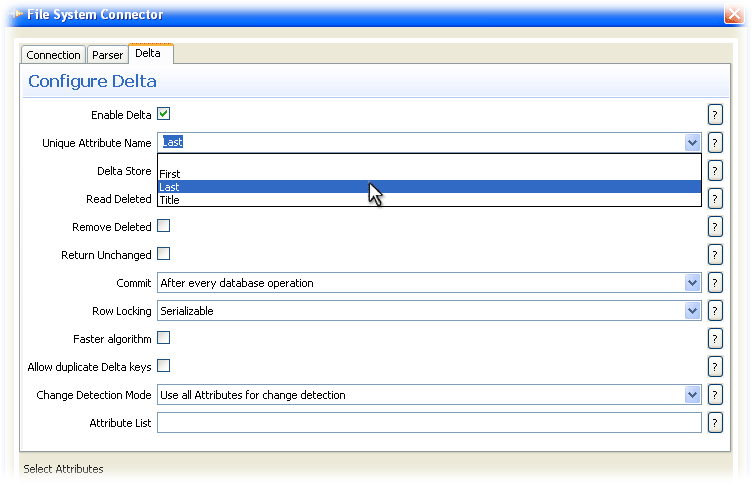
You must first enable the Delta Engine by selecting the checkbox at the top of the con-figuration panel. Then use the drop-down to select ‘First' as the Unique Attribute Name2.
There are several other parameters available here, some of which make more sense when working in the standard TDI Workbench and not in EasyETL. For example, al-though an EasyETL AssemblyLine can detect and transfer new and modified entries, it will not han-dle deleting a row from a database or entry in a directory. However, it will write this infor-mation to an Output target like a File System Connector with the LDIF Parser. LDIF files can contain change operation tags, and some systems support LDIF import.
We can learn more about the full Delta Handling features of TDI here:
http://www.tdi-users.org/twiki/pub/Integrator/HowTo/HowTo_SyncData_6.1.1070523.pdf
One change that you may wish to make is to the Commit parameter. This controls when new and changed snapshots are committed to the TDI System Store database. By default this is set to ‘After every database operation' and so occurs during the read phase.
However, if you wish to ensure that a change has been successfully transferred before committing the snapshot, set this drop-down to ‘On end of AssemblyLine cycle' instead so that it happens after the Output target has been updated.
In order for the Delta Engine to do its work it needs a baseline snapshot set. You create this by running your ETL job the first time after Delta has been enabled. Once it has completed we will notice that the popup reports twice as many writes occurring. This is because TDI also counts the snapshots being written to the System Store, so you get two writes for every entry processed.
Try running your EasyETL AssemblyLine again and we will see that no entries were written this time. The Delta Engine detected that input records were all unchanged and skipped them.
All entries unchanged and skipped
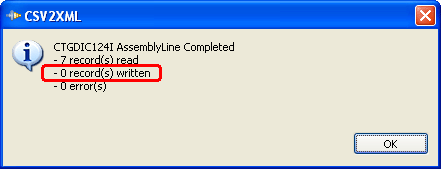
As a final test, bring up the input CSV file and change any of the field values - except for ‘Last'3. Save the change and then re-run your ETL job and we will see that only modified entries are processed.
Configuring the output target for Updates
The current setup works fine for output to a file. However, if you were driving these changes to a directory, RDBMS or similar data store then we will want to add new data as well as updating existing records. In order for your EasyETL job to do this first select which Output Attribute to use as the criteria for locating the record to modify.This is done by right-clicking on the desired Output Attribute and selecting the Use as link criteria option.
Selecting your link criteria
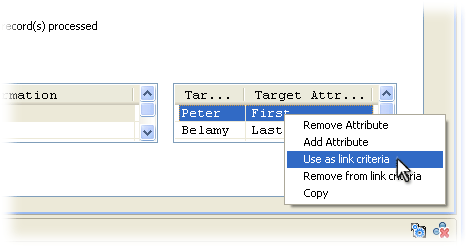
Now when the Output Connector writes to the target, it first searches for a record using the Link Criteria attribute specified. If no match is found then a new entry is added. If the match was successful then this record is updated.
It's as simple as that: your ETL job has now been configured to provide ongoing synchronization between your input source and output target.
Command line assets for running and scheduling your ETL job
Once your ETL AssemblyLine is ready for deployment we can right-click on the Project in the Navigator and choose the Create files neededoption.Creating command line assets to run the ETL job

This brings up an Export Files dialog where to write this script/batch-file. Note that it will be given the same name as the Project, so in the case of this tutorial exercise running on Windows it will be called ‘CSV2XML.bat'. Executing your EasyETL Project from the command line provides maximum performance for the solution.
You will also get an XML file created in the same location. This is called a TDI Config file and contains the details of the EasyETL AssemblyLine that the TDI Server needs to run it. If we open the generated script in a text editor we will see the one-liner needed to start a TDI Server, point it at a Config and then specify the AssemblyLine to run. All we need to do now is set up a scheduled task or cronjob to periodically invoke this script and your synchronization/migration service will be in place.
Additional options
High Speed ETL
Although the Data Collector is a powerful tool, your ETL AssemblyLine runs slower due to data collection and presentation on screen. If instead we want your EasyETL AssemblyLine to process as quickly as possible then you can either select the Project and press the Run button at the top of the Navigator, or right-click the Project and select the Run fastoption.
Run the ETL job at full speed
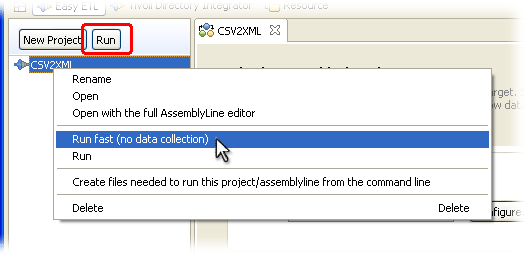
Either option will open a console display where log messages from the AssemblyLine will appear as your AssemblyLine executes at top speed.
Note that the Run option in the Project context menu runs the ETL job with data collection.
Filtering the input data set
Another powerful feature is the ability to control the contents of the Input data set. This is available whenever your Input source is a database or directory.
For example, select the ‘LDAP Connector' for input and take a look at the configuration dialog for this component. Next to the Search Filter parameter is a button labeled with three dots (…). This opens up the Link Criteria editor where we can define search rules that will be applied to build the result set for this Connector to read.
Defining Link Criteria for an Input Connector
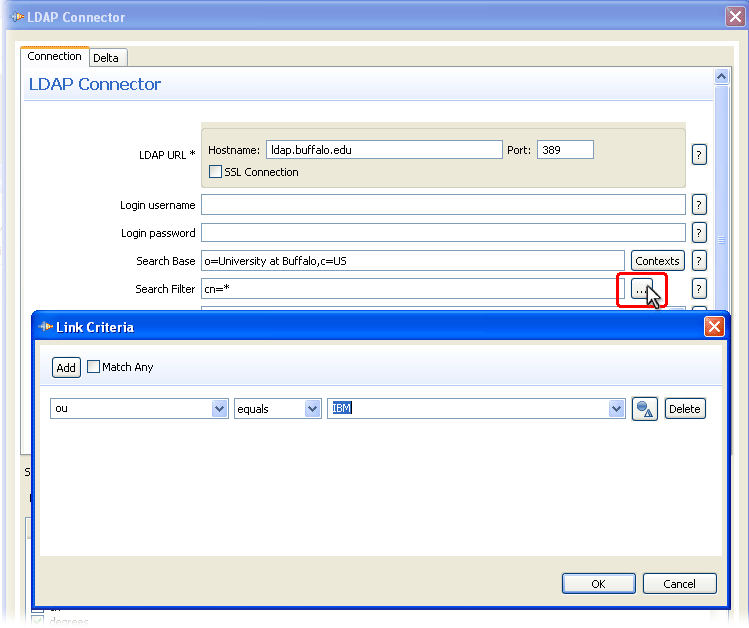
This same feature is available for the Database and JDBC Connectors, where you'll find the (...) button next to the Select parameter.
Although we can enter the LDAP search syntax yourself directly in the search parameter, this requires you to know the syntax for LDAP search filters or JDBC Select statements. It is often simpler to express the desired selection by using Link Criteria and letting the Connector deal with the underlying syntax.
Taking your EasyETL AssemblyLine to the next level
Opening your ETL Project in the full-featured TDI AssemblyLine editor lets you to add custom logging and auditing, error handling, failover logic, auto-reconnect, data augmentation (joins) and much more to our migration or synchronization solution. You do this by right-clicking a Project and choosing the Open with full AssemblyLine editor option. You'll still be working in the EasyETL Workbench, but we will be able to reach additional functionality available to our AssemblyLine.
If you find this to our liking and are ready to take the plunge then switch to the TDI perspective (Windows > Open Perspective > TDI) and starting working in the full TDI Workbench. Better yet - now that you've mastered EasyETL, go back to Chapter 1 and start digging into the full power of TDI.
Parent topic: EasyETL Guide
1 Note that the General Purpose Edition of TDI only offers the Change Detection Connector for databases (RDBMS's), while the Identity Edition includes those for a number of other systems, like Tivoli Directory Server, Domino and Sun One.
2 As you may have deduced, the Delta Engine uses one of the input attributes to uniquely identify snap-shots. If there is there is no unique value available in the input data then we can specify multiple attributes that will be concatenated together to from the snapshot id. You do this by typing in the names of multiple attributes separated by a plus symbol (+). For example: First + Last
3 Since this is the attribute
used to identify snapshots, any change to its value for an entry will
cause it to appear as a new record to the Delta Engine.